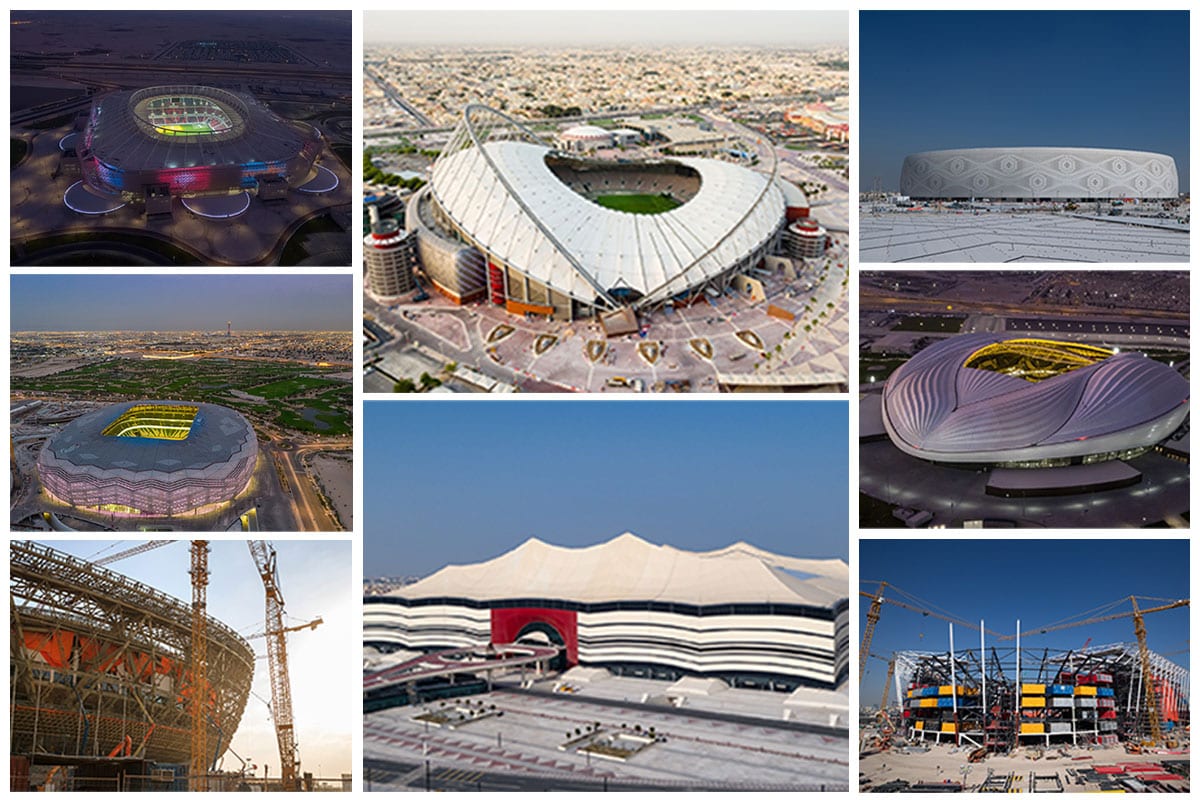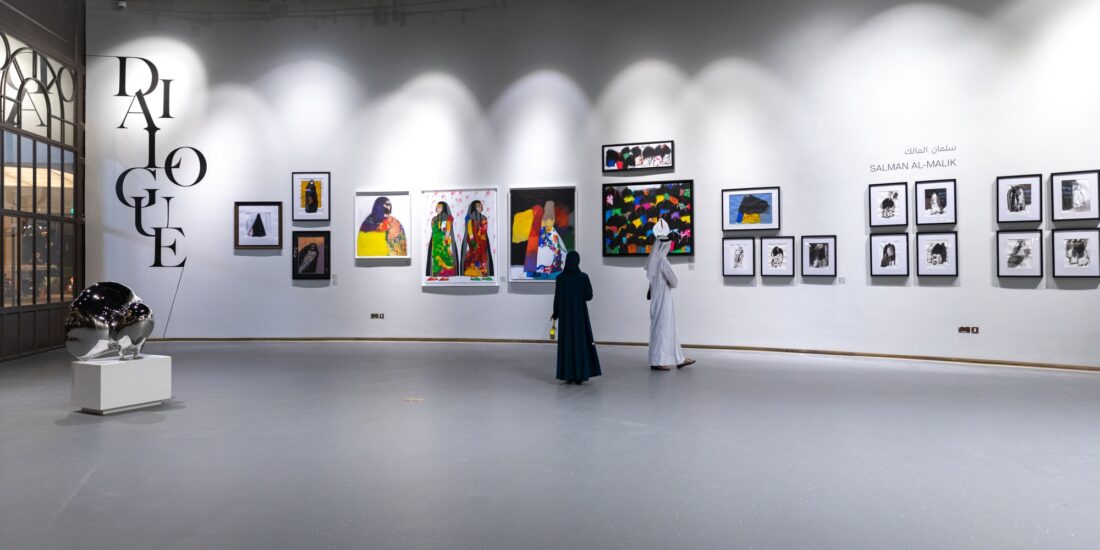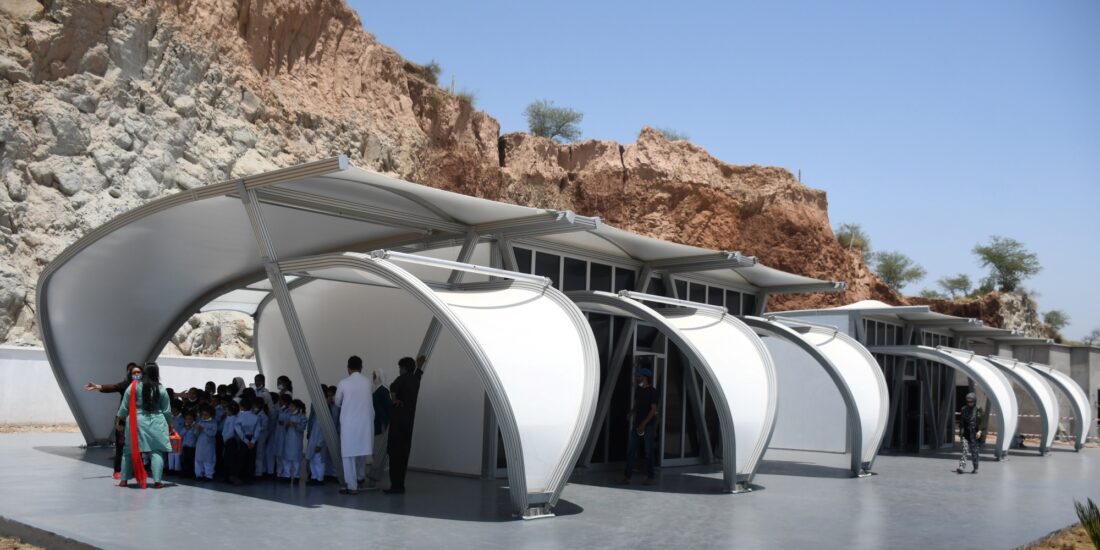The Stadiums of the FIFA World Cup Qatar 2022
With less than two years to go to the FIFA World Cup Qatar 2022™, SCALE checks out the progress of stadium construction and launches. Check out the stadium status and the architecture of each of the stunning designs.
One of the major highlights of 2020 was the virtual launch of Education City Stadium, which took place amidst protective measures implemented by the State of Qatar to prevent the spread of COVID-19. The stadium’s successful completion was dedicated to frontline workers who have worked tirelessly during the ongoing pandemic, according to the Supreme Committee for Delivery & Legacy.
Later in the year, on Qatar National Day, on December 18, and in the presence of His Highness the Amir, Sheikh Tamim bin Hamad Al Thani, Ahmad Bin Ali Stadium was unveiled to the world in a spectacular ceremony during the 48th Amir Cup final — making it the fourth fully operational Qatar 2022 tournament venue to be inaugurated.
Four more stadiums are being constructed for Qatar 2022, with Al Bayt Stadium in the final stages of delivery.
“All the venues will be completed and tested well in advance of the tournament, which kicks off on 21 November 2022,” said the Supreme Committee for Delivery & Legacy.
Al Bayt Stadium
Capacity: 60,000
Designer: Dar Al-Handasah
Distance from Doha city centre: 43km (27 miles) A remarkable sight will welcome fans to Al Bayt Stadium, which is being delivered by Aspire Zone Foundation. Designed to represent Arab hospitality, the venue will host nine matches through to the semi-finals stage of Qatar 2022 and is covered by a structure resembling a traditional Arab tent known as ‘bayt al sha’ar’, complete with a state-of-the-art retractable roof.
A remarkable sight will welcome fans to Al Bayt Stadium, which is being delivered by Aspire Zone Foundation. Designed to represent Arab hospitality, the venue will host nine matches through to the semi-finals stage of Qatar 2022 and is covered by a structure resembling a traditional Arab tent known as ‘bayt al sha’ar’, complete with a state-of-the-art retractable roof.
Construction update:
The stadium structure has been completed and is ready to host matches. This includes the laying of the stadium pitch in world record time. This year, the venue achieved a high sustainability rating from the Global Sustainability Assessment System (GSAS). The surrounding Al Bayt Park opened on Qatar National Sports Day in February.
Ahmad Bin Ali Stadium
Capacity: 40,000
Designer: Ramboll
Distance from Doha city centre: 22km (14 miles)
Stadium inaugurated in December 2020 Located in Al Rayyan, Ahmad Bin Ali Stadium is built on the site of a deconstructed stadium, with the new venue adjacent to the Mall of Qatar and within walking distance of Al Riffa Station – on Doha Metro’s Green Line.
Located in Al Rayyan, Ahmad Bin Ali Stadium is built on the site of a deconstructed stadium, with the new venue adjacent to the Mall of Qatar and within walking distance of Al Riffa Station – on Doha Metro’s Green Line.
The stadium’s glowing façade is comprised of patterns that characterise different aspects of Qatar: the importance of family, the beauty of the desert, native flora and fauna, and local and international trade. A fifth shape – a shield – brings together all the others, representing the strength and unity that is particularly relevant to the desert city of Al Rayyan.
The venue will host seven matches during Qatar 2022 up to the round of 16 stage. In 2021, the stadium will host matches during the FIFA Club World Cup Qatar 2020™, which will run from February 1-11.
Al Janoub Stadium
Capacity: 40,000
Design inspired by: Dame Zaha Hadid
Distance from Doha city centre: 23km (14 miles)
Stadium inaugurated in May 2019 Located in Al Wakrah with a design inspired by the late British-Iraqi architect Dame Zaha Hadid, the futuristic Al Janoub Stadium will host seven matches up to the round of 16 stage during Qatar 2022. The design is inspired by the sails of traditional dhow boats – in tribute to Al Wakrah’s seafaring past. An innovative cooling system and retractable roof mean the stadium can be used all year round.
Located in Al Wakrah with a design inspired by the late British-Iraqi architect Dame Zaha Hadid, the futuristic Al Janoub Stadium will host seven matches up to the round of 16 stage during Qatar 2022. The design is inspired by the sails of traditional dhow boats – in tribute to Al Wakrah’s seafaring past. An innovative cooling system and retractable roof mean the stadium can be used all year round.
The stadium was inaugurated on 16 May 2019 ahead of that year’s Amir Cup final. In December, Al Janoub hosted the 2020 AFC Champions League final. The surrounding Al Janoub Park opened on Qatar National Sports Day in February.
Al Thumama Stadium
Capacity: 40,000
Designer: Arab Engineering Bureau
Distance from Doha city centre: 13km (8 miles) The design of Al Thumama Stadium is inspired by the ‘gahfiya’, a traditional woven cap worn for centuries by men across the Arab world. It is the first FIFA World Cup venue to be designed by a Qatari architect – Ibrahim M. Jaidah. The stadium will host eight matches up to the quarter-finals stage during Qatar 2022.
The design of Al Thumama Stadium is inspired by the ‘gahfiya’, a traditional woven cap worn for centuries by men across the Arab world. It is the first FIFA World Cup venue to be designed by a Qatari architect – Ibrahim M. Jaidah. The stadium will host eight matches up to the quarter-finals stage during Qatar 2022.
“It is the coming together of all entities that was a learning curve for each one of us, that has made this engineering and architectural marvel a reality,” said Ibrahim Jaidah as the construction process comes to an end this year.
Construction update:
Roof and façade works have been completed, along with the stadium’s bleacher installation. Seat installation, along with mechanical, electrical and plumbing works, plus finishing, are ongoing.
Education City Stadium
Capacity: 40,000
Designer: FIA Fenwick Iribarren Architects
Distance from Doha city centre: 12km (7 miles)
Stadium inaugurated in June 2020
 Education City Stadium is located at the heart of Qatar Foundation – a vibrant centre for knowledge and innovation where this ultramodern arena is a fitting addition and lasting symbol of sustainability. The stadium will host eight matches up to the quarter-finals stage during Qatar 2022.
Education City Stadium is located at the heart of Qatar Foundation – a vibrant centre for knowledge and innovation where this ultramodern arena is a fitting addition and lasting symbol of sustainability. The stadium will host eight matches up to the quarter-finals stage during Qatar 2022.
The stadium became the first Qatar 2022 tournament venue to receive a five-star GSAS sustainability rating ahead of its virtual inauguration in June 2020. More recently, Education City hosted matches in the West Zone of the 2020 AFC Champions League and was also a venue for the East Zone portion of the competition. The stadium will host matches during the upcoming FIFA Club World Cup 2020™, including the final.
Khalifa International Stadium
Capacity: 40,000
Distance from Doha city centre: 13km (8 miles)
Stadium inaugurated in May 2017
 On 19 May 2017, Khalifa International Stadium became the first Qatar 2022 stadium to open when it hosted the Amir Cup final in front of more than 40,000 fans. Located in Aspire Zone, the historic venue has previously hosted the Asian Games and the AFC Asian Cup. The stadium is set to host eight matches up to the third-place play-off during Qatar 2022.
On 19 May 2017, Khalifa International Stadium became the first Qatar 2022 stadium to open when it hosted the Amir Cup final in front of more than 40,000 fans. Located in Aspire Zone, the historic venue has previously hosted the Asian Games and the AFC Asian Cup. The stadium is set to host eight matches up to the third-place play-off during Qatar 2022.
Recent events to have taken place at Khalifa International include the 2019 IAAF World Athletics Championships, the 24th Arabian Gulf Cup and the FIFA Club World Cup Qatar 2019™. In 2020, the stadium hosted matches in the West Zone of the 2020 AFC Champions League and was also a venue for the East Zone portion of the competition. Along with Education City and Ahmad Bin Ali, the stadium will host matches during the FIFA Club World Cup in February.
Lusail Stadium
Capacity: 80,000
Designer: Foster + Partners
Distance from Doha city centre: 16km (10 miles)
 The 80,000-seat Lusail Stadium will embody Qatar’s ambition, along with its passion for sharing Arab culture with the world. The design of this magnificent stadium is inspired by the interplay of light and shadow that characterises the fanar lantern. The venue will also become the centrepiece of Lusail – a newly built, state-of-the-art metropolis, designed specifically with residents’ needs in mind. The stadium will host ten matches up to and including the final of Qatar 2022.
The 80,000-seat Lusail Stadium will embody Qatar’s ambition, along with its passion for sharing Arab culture with the world. The design of this magnificent stadium is inspired by the interplay of light and shadow that characterises the fanar lantern. The venue will also become the centrepiece of Lusail – a newly built, state-of-the-art metropolis, designed specifically with residents’ needs in mind. The stadium will host ten matches up to and including the final of Qatar 2022.
Construction update:
The stadium’s concrete works, bowl steel installation and the first phase of the roof big lift have been completed with preparation for the final phase ongoing. The skybox and hospitality lounge pitch-facing glazing has been completed. Meanwhile, the installation of the stadium’s steel structure and façade are ongoing, as are the mechanical, engineering, plumbing and finishing works.
Ras Abu Aboud Stadium
Capacity: 40,000
Designer: FIA Fenwick Iribarren Architects
Distance from Doha city centre: 10km (6 miles) Ras Abu Aboud Stadium will be the first fully demountable and re-usable tournament venue in FIFA World Cup history. Designed by Fenwick Iribarren Architects, this 40,000-capacity stadium will be built using shipping containers and other modular materials. Overlooking the stunning Doha Corniche and West Bay skyline, the stadium will host seven matches up to the round of 16 stage during Qatar 2022.
Ras Abu Aboud Stadium will be the first fully demountable and re-usable tournament venue in FIFA World Cup history. Designed by Fenwick Iribarren Architects, this 40,000-capacity stadium will be built using shipping containers and other modular materials. Overlooking the stunning Doha Corniche and West Bay skyline, the stadium will host seven matches up to the round of 16 stage during Qatar 2022.
Construction update:
The stadium is being built using 998 modular containers, with the delivery and installation of all containers now completed. This includes special containers for the completed Kahramaa primary substation. All remaining structural steel members, including tension rods, have also been delivered and installed. Installation of all seats in the stadium’s bowl has also been completed.




